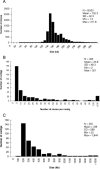A BAC-based physical map of the Drosophila buzzatii genome
- PMID: 15930498
- PMCID: PMC1142479
- DOI: 10.1101/gr.3263105
A BAC-based physical map of the Drosophila buzzatii genome
Abstract
Large-insert genomic libraries facilitate cloning of large genomic regions, allow the construction of clone-based physical maps, and provide useful resources for sequencing entire genomes. Drosophila buzzatii is a representative species of the repleta group in the Drosophila subgenus, which is being widely used as a model in studies of genome evolution, ecological adaptation, and speciation. We constructed a Bacterial Artificial Chromosome (BAC) genomic library of D. buzzatii using the shuttle vector pTARBAC2.1. The library comprises 18,353 clones with an average insert size of 152 kb and an approximately 18x expected representation of the D. buzzatii euchromatic genome. We screened the entire library with six euchromatic gene probes and estimated the actual genome representation to be approximately 23x. In addition, we fingerprinted by restriction digestion and agarose gel electrophoresis a sample of 9555 clones, and assembled them using FingerPrint Contigs (FPC) software and manual editing into 345 contigs (mean of 26 clones per contig) and 670 singletons. Finally, we anchored 181 large contigs (containing 7788 clones) to the D. buzzatii salivary gland polytene chromosomes by in situ hybridization of 427 representative clones. The BAC library and a database with all the information regarding the high coverage BAC-based physical map described in this paper are available to the research community.
Figures


Similar articles
-
A BAC-based physical map of the Hessian fly genome anchored to polytene chromosomes.BMC Genomics. 2009 Jul 2;10:293. doi: 10.1186/1471-2164-10-293. BMC Genomics. 2009. PMID: 19573234 Free PMC article.
-
Feasibility of physical map construction from fingerprinted bacterial artificial chromosome libraries of polyploid plant species.BMC Genomics. 2010 Feb 19;11:122. doi: 10.1186/1471-2164-11-122. BMC Genomics. 2010. PMID: 20170511 Free PMC article.
-
Construction and characterization of a soybean bacterial artificial chromosome library and use of multiple complementary libraries for genome physical mapping.Theor Appl Genet. 2004 Sep;109(5):1041-50. doi: 10.1007/s00122-004-1712-y. Epub 2004 May 26. Theor Appl Genet. 2004. PMID: 15164176
-
A BAC-based physical map of the channel catfish genome.Genomics. 2007 Sep;90(3):380-8. doi: 10.1016/j.ygeno.2007.05.008. Epub 2007 Jun 20. Genomics. 2007. PMID: 17582737
-
Physical map and gene survey of the Ochrobactrum anthropi genome using bacterial artificial chromosome contigs.Microb Comp Genomics. 1999;4(3):203-17. doi: 10.1089/omi.1.1999.4.203. Microb Comp Genomics. 1999. PMID: 10587947
Cited by
-
Gene alterations at Drosophila inversion breakpoints provide prima facie evidence for natural selection as an explanation for rapid chromosomal evolution.BMC Genomics. 2012 Feb 1;13:53. doi: 10.1186/1471-2164-13-53. BMC Genomics. 2012. PMID: 22296923 Free PMC article.
-
The 19 genomes of Drosophila: a BAC library resource for genus-wide and genome-scale comparative evolutionary research.Genetics. 2011 Apr;187(4):1023-30. doi: 10.1534/genetics.111.126540. Epub 2011 Feb 14. Genetics. 2011. PMID: 21321134 Free PMC article.
-
A transgenomic cytogenetic sorghum (Sorghum propinquum) bacterial artificial chromosome fluorescence in situ hybridization map of maize (Zea mays L.) pachytene chromosome 9, evidence for regions of genome hyperexpansion.Genetics. 2007 Nov;177(3):1509-26. doi: 10.1534/genetics.107.080846. Epub 2007 Oct 18. Genetics. 2007. PMID: 17947405 Free PMC article.
-
Cloning and sequencing of the breakpoint regions of inversion 5g fixed in Drosophila buzzatii.Chromosoma. 2009 Jun;118(3):349-60. doi: 10.1007/s00412-008-0201-5. Epub 2009 Feb 7. Chromosoma. 2009. PMID: 19198866
-
Cotton genome mapping with new microsatellites from Acala 'Maxxa' BAC-ends.Mol Genet Genomics. 2006 May;275(5):479-91. doi: 10.1007/s00438-006-0106-z. Epub 2006 Feb 25. Mol Genet Genomics. 2006. PMID: 16501995
References
-
- Adams, M.D., Celniker, S.E., Holt, R.A., Evans, C.A., Gocayne, J.D., Amanatides, P.G., Scherer, S.E., Li, P.W., Hoskins, R.A., Galle, R.F., et al. 2000. The genome sequence of Drosophila melanogaster. Science 287: 2185-2195. - PubMed
-
- Barker, J.S.F. and Starmer, W.T., eds. 1982. The cactus-yeast-Drosophila model system. Academic Press, Sydney, Australia.
-
- Barker, J.S.F., Starmer, W.T., and MacIntyre, R., eds. 1990. Ecological and evolutionary genetics of Drosophila. Plenum Press, New York.
-
- Betrán, E., Santos, M., and Ruiz, A. 1998. Antagonistic pleiotropic effect of second-chromosome inversions on body size and early life-history traits in Drosophila buzzatii. Evolution 52: 144-154. - PubMed
-
- Casals, F., Cáceres, M., and Ruiz, A. 2003. The Foldback-like transposon Galileo is involved in the generation of two different natural chromosomal inversions of Drosophila buzzatii. Mol. Biol. Evol. 20: 674-685. - PubMed
WEB SITE REFERENCES
-
- http://bacpac.chori.org/; BACPAC Resources Center at Children's Hospital Oakland Research Institute.
-
- http://rana.lbl.gov/drosophila/multipleflies.html; Assembly/Alignment/Annotation of 12 Drosophila Genomes.
-
- http://taxodros.unizh.ch/; The database on Taxonomy of Drosophilidae.
-
- http://tdgc.arl.arizona.edu/baclibraries.htm; Tucson Drosophila Genomics Consortium.
-
- http://www.bcgsc.ca/ice; Internet Contig Explorer (iCE) download from the Genome Sciences Centre (British Columbia Cancer Agency) server.
Publication types
MeSH terms
LinkOut - more resources
Full Text Sources
Molecular Biology Databases
